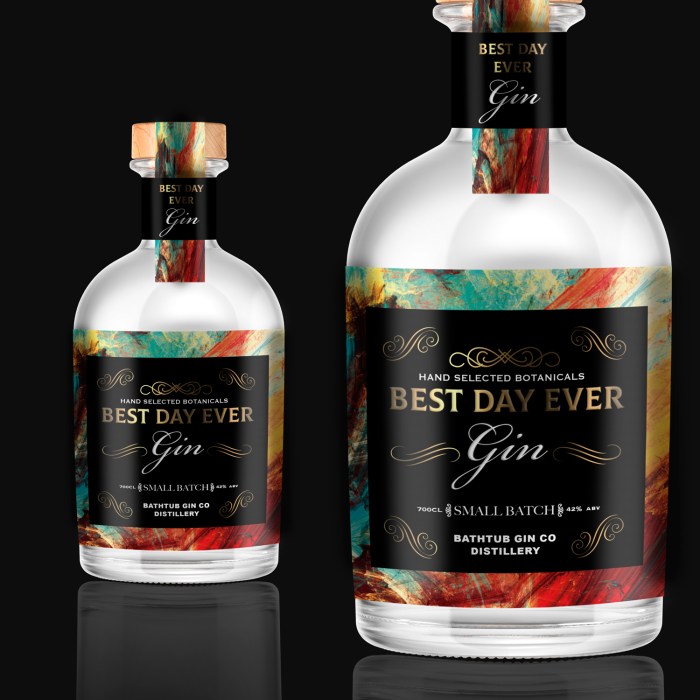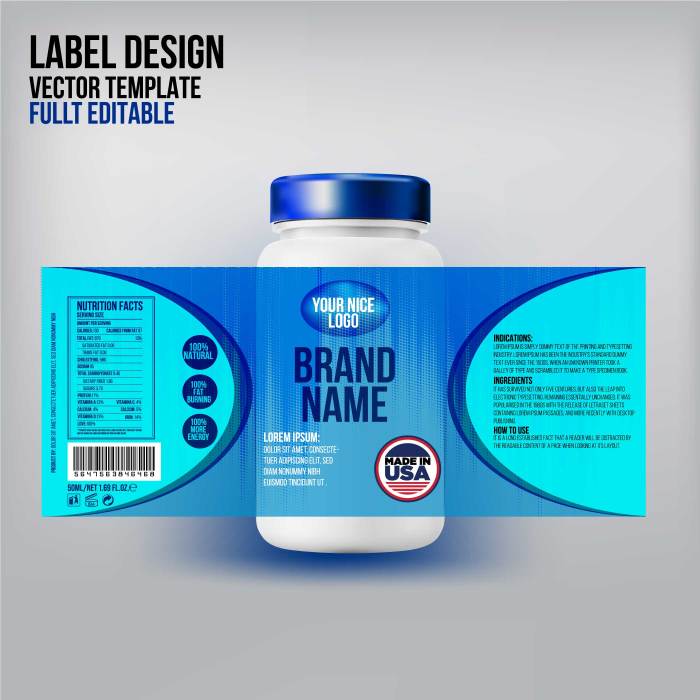Label Design: Enhancing Product Packaging with Visual Creativity
Kicking off with label design, this topic delves into the pivotal role that visual aesthetics play in product packaging. From grabbing consumer attention to influencing purchasing decisions, a well-crafted label design can make a significant impact on a brand's success.
Exploring the key elements that constitute an effective label design and how they shape consumer perception, this discussion will provide valuable insights into the art and science of creating visually appealing labels.
Importance of Label Design
Label design plays a crucial role in product packaging as it serves as the first point of contact between the consumer and the product. An effective label design can capture the attention of potential buyers, convey important information about the product, and ultimately influence purchasing decisions.
Key Elements of Effective Label Design
- Clear and Legible Text: Ensure that all information on the label is easy to read and understand.
- Eye-catching Visuals: Use colors, images, and graphics that are visually appealing and relevant to the product.
- Branding Consistency: Maintain consistency with your brand's logo, colors, and overall design aesthetic.
- Product Information: Include essential details such as ingredients, usage instructions, and any relevant certifications or labels.
- Differentiation: Make sure your product stands out on the shelf by highlighting its unique selling points.
Impact on Consumer Perception and Purchasing Decisions
Consumers often make split-second decisions when choosing products, and label design can significantly influence their perception and purchasing behavior. A well-designed label can convey quality, trustworthiness, and value, making the product more appealing to potential buyers. On the other hand, a poorly designed label may deter consumers, leading them to choose a competitor's product instead.
Elements of an Effective Label Design
Effective label design plays a crucial role in capturing the attention of consumers and conveying important information about a product. Let's explore the essential components that make a label design successful.
Essential Components of a Successful Label Design
- Clear and Concise Information: A successful label design should provide essential information about the product in a clear and concise manner. This includes product name, brand logo, ingredients, usage instructions, and any relevant warnings or certifications.
- Eye-catching Graphics: Engaging graphics and images can help attract the attention of consumers and make the product stand out on the shelves. The visual elements should be relevant to the product and resonate with the target audience.
- Legible Fonts: Choosing the right fonts is crucial for ensuring that the text on the label is easily readable. The font style and size should be appropriate for the information being conveyed, making it accessible to all consumers.
- Color Schemes: The color scheme of a label can evoke different emotions and associations. It is important to select colors that align with the brand identity and product positioning. Consistent use of colors can also help in brand recognition.
- Compliance with Regulations: Labels must comply with legal requirements and industry standards. Including mandatory information such as barcodes, nutrition facts, and safety warnings is essential for regulatory compliance.
Role of Color Schemes, Fonts, and Graphics in Label Design
Using an appropriate color scheme, fonts, and graphics can significantly impact the overall effectiveness of a label design. Colors can convey emotions and influence consumer perception, while fonts contribute to readability and brand identity. Graphics help in visually communicating the product's unique selling points and enhancing its appeal.
Examples of Well-Designed Labels
Some examples of well-designed labels include the minimalist and elegant label of Apple products, the vibrant and playful label of Innocent smoothies, and the classic and sophisticated label of Chanel perfumes. These labels stand out due to their careful attention to detail, use of high-quality graphics, and consistency in branding elements.
Trends in Label Design

In the ever-evolving world of design, label design is no exception to the trends that shape the industry. Let's explore some of the current trends influencing label design across different industries.
Minimalism in Label Design
Minimalism continues to be a dominant trend in label design, with many brands opting for clean, simple designs that focus on essential information. This trend not only enhances readability but also gives labels a modern and sophisticated look.
Sustainability in Label Design
With the growing emphasis on sustainability and eco-consciousness, many brands are incorporating sustainable practices into their label designs. This includes the use of recycled materials, biodegradable labels, and environmentally friendly printing techniques.
Digitalization in Label Design
The digital revolution has also made its mark on label design, with brands leveraging technologies like augmented reality and QR codes to create interactive and engaging labels. This trend not only enhances consumer experience but also provides brands with valuable data insights.
Innovative Materials and Finishes
Modern label design is also seeing a rise in the use of innovative materials and finishes to create unique and eye-catching labels. From textured papers to holographic foils, brands are pushing the boundaries of traditional label design to stand out on the shelves.
Design Process for Label Creation
Creating a label design involves a detailed step-by-step process that includes research, brainstorming, concept development, prototyping, and testing. Each stage is crucial in ensuring the final label effectively communicates the intended message and resonates with the target audience.
Research
Research is the foundational step in the label design process. It involves gathering information about the product, target market, competitors, and industry trends. Understanding the market landscape helps in creating a design that stands out and connects with consumers.
Brainstorming Ideas
Once research is complete, the next step is to brainstorm ideas for the label design. This stage involves generating creative concepts, exploring different visual elements, typography, and color schemes that align with the brand identity and product positioning.
Concept Development
After brainstorming, the chosen ideas are further developed into concrete design concepts. This stage focuses on refining the visual elements, typography, layout, and overall composition of the label. It is essential to create a design that not only looks visually appealing but also effectively conveys the brand message.
Prototyping and Testing
Prototyping involves creating a preliminary version of the label design to visualize how it will appear on the actual product packaging. Testing the prototype with focus groups or target consumers helps gather feedback on the design's effectiveness, readability, and overall impact.
Iterating based on feedback is crucial to refining the label design before final production.
Compliance and Regulations in Label Design

Ensuring compliance with labeling regulations and standards is crucial for businesses across various industries. Failure to meet these requirements can result in fines, legal issues, and damage to a company's reputation.
Common Legal Requirements for Labels
- Accurate Product Information: Labels must provide correct details about the product, including ingredients, usage instructions, and any warnings.
- Country-Specific Regulations: Labels may need to adhere to specific regulations in different countries, such as language requirements, metric measurements, or safety warnings.
- Allergen Information: Labels should clearly indicate if a product contains common allergens to ensure consumer safety.
- Health and Safety Warnings: Certain industries, like pharmaceuticals or chemicals, require labels to display specific health and safety warnings to protect users.
Ensuring Label Design Compliance
- Research Regulations: Stay informed about industry-specific regulations and regularly check for updates to ensure label compliance.
- Work with Legal Experts: Collaborate with legal professionals to review label designs and confirm they meet all necessary regulations.
- Testing and Review: Conduct thorough testing and review processes to verify that the label design complies with all legal requirements before printing and distribution.
Outcome Summary
In conclusion, label design is not just about aesthetics; it's a strategic tool that can set a product apart on the shelves. By understanding the importance of design elements, staying updated on trends, and ensuring compliance with regulations, brands can elevate their packaging and leave a lasting impression on consumers.
FAQ Summary
What role does color play in label design?
Colors evoke emotions and can influence consumer perception. Choosing the right color scheme is crucial for conveying brand identity and attracting target audiences.
How important is it to prototype and test label designs?
Prototyping helps in visualizing the final product and testing ensures that the design is effective and resonates with the target market before mass production.
What are some common labeling regulations that brands need to comply with?
Labels must include accurate product information, comply with FDA guidelines, display proper warnings, and adhere to specific industry standards to ensure consumer safety and transparency.




